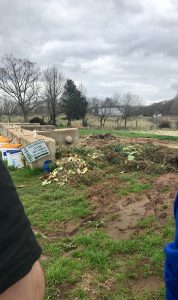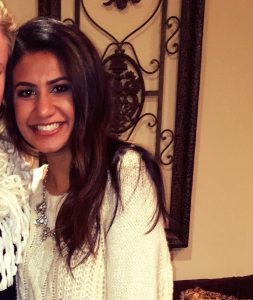1. I worked on the Prevalence of Antibiotic Resistance in the Environment Lab and the Outreach Project to Clarke County High School. At the High School I, with my classmates, interacted with the students in groups as the students counted their data and entered it into the online spreadsheet.
2. For the project, my partner and I first worked on the Prevalence of Antibiotic Resistance Lab. The lab consisted of acquiring soil samples and performing a systematic dilution. We transferred the diluted soil samples to Petri plates, which had a bacterial growth medium with and without tetracycline. We then counted and recorded the number of bacterial colonies to calculate the frequency of tetracycline resistance in the soil samples. We also arranged plates for the high school students so that they were also able to count their colonies and enter it into the database. At the high school, I assisted the students in explaining what was meant by a “colony” and how they should be counted. We then entered our data into the national database for PARE researchers to perform regional comparisons and analysis on antibiotic resistance prevalence. As preparation for the lab and the outreach project, much of the research came from learning in class. This was through learning about the antibiotic resistance process and how mutations can result in resistance. These lessons facilitated my understanding of antibiotic resistance in the soil. This research may be similar to something I may do in the future because the soil is something that will always remain a necessity. Understanding the basics of antibiotic resistance can be helpful when put in a situation where analyzation of resistant microbes in an affected area is needed and I already have some background knowledge of what this means and entails. This would especially be useful if I am trying to educate someone on the topic. Also, since technology is constantly getting integrated into society in such clever ways, and being that I am a computer science major, my future may consist on working on a project relating to the environment and antibiotic resistance.
3. How did you gain information about your topic:
- In class, powerpoints helped me understand the background of antibiotic resistance and what this means.
- It also helped my understanding when I researched the outcomes of antibiotics in soil
- Reading the lab manual and understanding the purpose and goals of the lab helped me realize the overall target and objective of assignment.
What did you learn about your topic through this project:
- The overall goal of this project was to determine the percent of tetracycline resistant bacterial cells in each soil. This will loosely give us an insight of the total number of antibiotic-resistant bacteria in the soil. After all groups had entered in their data, it can be observed that the percentage of resistant cells was mostly under 1% with a few around 20-30% for TET30R and many of the TET3R percentages under 20%.
Did presenting on the topic cause you to get to know the subject matter better?
- Yes, firstly it was easier to tell the high school students how to count the colonies since we had done this in the previous class with our own soil samples. The high school students’ data also reaffirmed our data since they also got percentages mostly under 1% for TET30R and percentages mostly under 20% for TET3R.
4. The characteristic of the presentation of being intellectually stimulating was incorporated into the outreach project by allowing for the high schoolers to bring in their own soil. Seeing that many of the high schoolers most likely brought soil from their own background or a place he or she may be familiar with made the research all the more interesting. This is because the high school students are able to analyze and hopefully comprehend the results a little bit better knowing that this is not some “special soil” but instead soil that he or she sees every day. The presentation was also relevant to the audience, high school students, because the high school students were able to interact with the college students. I think this allowed for an overall relatable and low-pressure atmosphere knowing that we were all students working on the same lab. I believe it also made it easier for the high school students to be interested in the lab since a college student was also there and able to casually communicate with them. The presentation was also creative because, for the most part, it was hassle free. We had organized the Petri dishes beforehand by already labeling them. This easily allowed for the students to count their colonies and enter it online.
5. During the outreach project, I saw myself as being more confident. I think this is because if the high school students were confused or had any questions I was there to help them. I had to make sure to carefully walk them through on what they had to do. Science is not my strong suit, usually, the objective and goals of labs are difficult for me to grasp. However, when communicating with the high school students, I realized that I knew more than I thought I did. I think this also came from having to explain the procedure to the high school students. Whenever I have to explain something to someone else, it always affirms my own understandings as well. Being that I am a computer science major, I feel like using technology also made me feel more comfortable with the project.
6. I analyzed the audience by thinking back to my own AP environmental class in high school. As I said before, labs are sometimes a little difficult for me to understand and I usually need to analyze the instructions a couple times to gain the full understanding. With this in mind, I made sure to approach the high school students in a way that made their part in contributing to the research in a simple and easy to follow along way. I prepared for the presentation by reading back over what the high school students would be doing and thinking about possible areas where they would need help, so that if someone did have a question I would be able properly to assist him or her. I can apply this approach to future communication efforts by realizing that not everyone I speak to will be as educated on interested in what I am talking about. Knowing this, I will have to adjust my way of explaining and presentation of the topic to still capture the other person’s attention and keep he or her engage in the topic.
7. If done this project again, I would read over the lab initially more carefully. I feel like this may have eliminated some of the confusion when working with the soil the first time around with my partner.
8. This experience better helped me understand the course by first performing an experiment on antibiotic resistance in the soil, which is in line with the objectives of the overall course, and applying it in a social setting by communicating with high school students. Realizing that it is important to keep the high school students engaged meant that I needed to understand the goals and objectives of the assignment and properly communicate this to the students so that they were given the information and not waiting around and losing interest. Explaining and communicating with the high school students helped me understand the assignment better and the importance of the numbers that were having to be calculated since this is what the high school students had to do too. So, if they had any questions I needed to made sure I explained it to them in an easy-to-follow-along way.
9. I can use what I learned from this experience in the future definitely in the way I communicate with people, especially to those who may not be as educated on a topic as I may be. Many people may define themselves as “not being a computer person” or “not being able to work with technology.” Being that I am a computer science major, I need to make sure that when I am trying to explain a project I may be working on to someone who may not have any interest in technology that I communicate in terms that still keep a person engaged and interested in what I am talking about.
10. I hope I came across as approachable and educational. I hope that the high school students felt comfortable enough to ask questions and I was able to deliver with information that was informative enough to where their confusions were eliminated. In the future, I would go in feeling confident in the subject. I think the best way to achieve this is by doing extra research beforehand and acquiring relatable information that can be applied to the subject. I believe that this will allow me to gain all perspectives on the subject and realize the problem at hand.
11. I believe this assignment was effective for me. This is because I was able to work on an assignment that is so relevant to my everyday life. Antibiotic bacteria in the soil affects all of us firsthand since the soil is something that we will continue to need. It was eye-opening to work on an assignment that looked into a subject that I can physically see and relate to. Feedback from communicating with the high school students also made the assignment effective because it helped me gain knowledge on the matter better and educate others on the matter as well!



